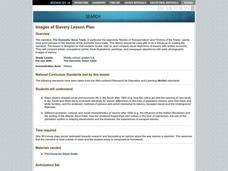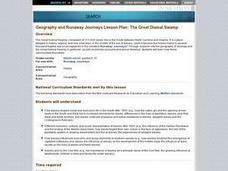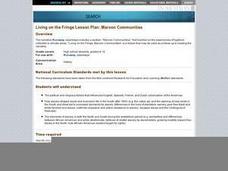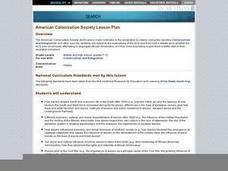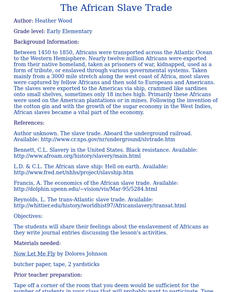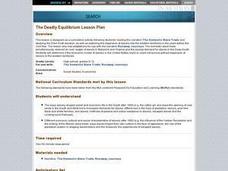Curated OER
The Cotton Gin
Students are introduced to an early American inventor, Eli Whitney, and his experiences with the Patent Office. The economic importance of the cotton gin and its impact on slavery are also addressed.
Curated OER
Eli Whitney's Patent for the Cotton Gin
High schoolers review the U.S. patent laws by researching Eli Whitney's petition for a renewal on his cotton gin patent. They examine documents to assess the impact of the cotton gin, role-play the patent hearing and discuss the effects...
Curated OER
King Cotton
Fifth graders examine the manufacturing of cotton. In this cotton and slavery lesson plan, 5th graders review background information about cotton and slavery. Students examine a real cotton ball and discuss why it was painful to pick....
Curated OER
Images of Slavery
Middle schoolers analyze the ways slavery shaped social and economic life in the South after 1800, methods of passive and active resistance to slavery; escaped slaves and the Underground Railroad, and the ending of the Atlantic slave trade.
Curated OER
King Cotton
Sixth graders investigate the farming process for cotton and its impact on the United States history. In this cotton farming lesson, 6th graders read background information on the cotton farming process and discuss the role of slavery in...
Curated OER
Slavery in the United States
Students investigate the personal accounts of slaves in the United States. They participate in various activities according to grade level to examine the role of slavery in the South.
Curated OER
Slavery, Manumission, and Freedom: Free Blacks in Charleston before the Civil War
Students explore the concept of slavery and manumission through a variety of activities. In this civil rights lesson plan, students gather information from primary sources, then analyze the politics and historical context of the time....
Curated OER
The Colonization of Liberia
Students analyze how slavery shaped social and economic life in the South. They study methods of passive and active resistance to slavery, and the similarities and differences between African-American and white abolitionists.
Curated OER
COTTON AND SLAVERY IN ARKANSAS
Fifth graders read about the cotton industry in America and demonstrate the roll of slaves picking and removing seeds from a boll of cotton. The relationship between slaves and cotton production is established.
Curated OER
THE GREAT DISMAL SWAMP
Students analyze how slavery shaped social and economic life in the South after 1800, the different economic, cultural, and social characteristics of slavery after 1800, and slavery both prior and after the Civil War.
Curated OER
Whitewashing Southern History
Students discuss the fact and fiction of slavery in the South. After viewing a video on two New Orleans plantations, they determine the accuracy of the facts presented. In the computer lab, they visit various sites and examine which ones...
Curated OER
Maroon Communities
Students examine political and religious factors that influenced English, Spanish, French, and Dutch colonization of the Americas, how slavery shaped social and economic life in the South after 1800, and elements of slavery during the...
Curated OER
Fugitive Slave Narratives
Students analyze the ways slavery shaped social and economic life in the South after 1800, the different economic, cultural, and social characteristics of slavery after 1800, and the ending of the Atlantic slave trade.
Curated OER
From Slave to Entrepreneur: The Life and Times of William Ellison
Eighth graders interpret historical evidence presented in primary and secondary resources. In this South Carolina history lesson, 8th graders examine sources that require them to examine the life of William Ellison, a black slave owner.
Curated OER
American Colonization Society Lesson Plan
Students read an article online "Colonization and Emigration" and break into debating groups. They research points that support their side, namely whether or not the American Colonization Society was for or against segregation. They...
Curated OER
Denmark Vesey's Rebellion
Students research the slave, Denmark Vesey, and create a dramatic play depicting his life.
National Endowment for the Humanities
Women's Lives Before the Civil War
Women's lifestyles before the Civil War made a huge impact as a point of causation. Give middle schoolers the opportunity to view firsthand the lives of women before the Civil War. They analyze primary source documents, view photographs,...
Curated OER
Road to War Assessment
In this American Civil War worksheet, students respond to 20 short answer, multiple choice, and true or false questions about the events that led to the outbreak of war.
National Endowment for the Humanities
People and Places in the North and South
North and South: two opposite directions and two opposite economic and social systems in time of the Civil War. Pupils peruse census websites and primary source photographs to understand what life was like for the everyday person before...
Curated OER
Three Coffles Lesson Plan
Students read about the slave trade in primary source documents. They discuss differences and commonalities in experiences. They write prose or poetry from the point of view of one of the figures from the reading and create a triptych.
Curated OER
The African Slave Trade
Students share their feelings about the enslavement of Africans as they write journal entries discussing their role play activity.
National Endowment for the Humanities
Factory vs. Plantation in the North and South
North is to factory as South is to plantation—the perfect analogy for the economy that set up the Civil War! The first lesson in a series of five helps teach beginners why the economy creates a driving force for conflict. Analysis of...
Curated OER
Forest Joe Lesson Plan: Outlaw or Hero?
Students become familiar with an American legend that is unfamiliar to many. Presented with the legend of Forest Joe, a runaway slave who, much like Robin Hood, stole from the rich to give to the poor, students draw comparisons and...
Curated OER
The Deadly Equilibrium Lesson Plan
Students read a narrative "The Domestic Slave Trade" and answer questions about states' slave trading. They read another narrative "Runaway Journey" and answer questions about runaway slaves. They discuss the impact of the slave trade on...





